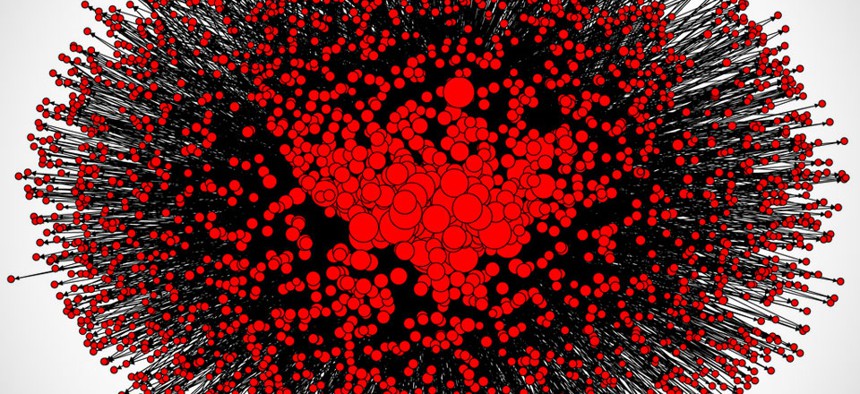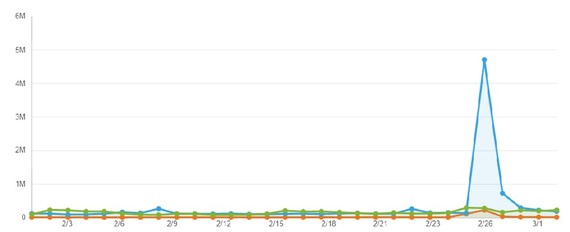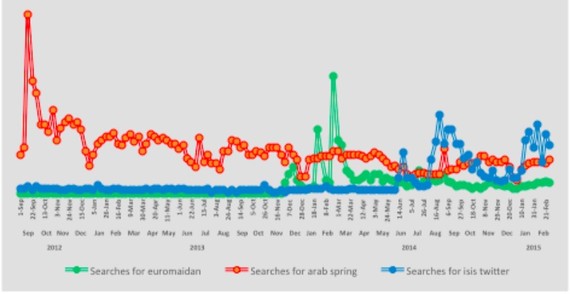How ISIS Succeeds on Social Media Where #StopKony Fails

A map of the top 50 Twitter PR presences in the UK and their respective followers. Flickr user Porter Novelli Global
Even with fewer clicks.
Social networks offer an incredible tool for tapping into the collective unconscious, a virtual Jungian arena in which competition might be expected to amplify the critical values and anxieties of millions of people in real time.
In early 2015, these critical issues included the ambiguous color of a random dress, the so-called Islamic State, and llamas— in that order .
Tweets Per Day: Llamas, Dress, and ISIS (February 1 —March 3, 2015)

How did we get here?
The answer to this question is, predictably, complex. Divining the mood of the masses has always been a tricky business. Prior to the rise of democracy, there were few consistent tools for this purpose, aside from counting how many pitchforks and torches the peasants were waving outside the gates. The vote became one way to quantify citizen priorities. But in practice, democracy is reductive. A finite number of candidates run for a finite number of offices, and the winners infer what their constituents want and need.
The explosion of affordable communications technologies allowed such inferences to become more accurate over time. Still, at every stage, reductionist influences kept whittling and shaping the raw data of public opinion. Pollsters decided what to ask and how to phrase the questions. Politicians decided which issues to exploit. News editors and producers made judgment calls about what was newsworthy.
Social media has introduced a new and profound layer of complication to how we listen to the voice of the masses. The technology has replaced the reductionism of the old world with a bafflingly dense ecosystem of echo and amplification. While this seems to cut out the middleman, the surging complexity of the system results in an unpredictable stew of dynamics that can create false impressions, such as that the rising terrorist threat in Iraq and Syria presents an existential threat to the world—despite the fact that ISIS, the terrorist group in question, possesses only tens of thousands of fighters and little popular support—or that that the perceived color of a dress is more important still, if only for a day.
* * *
Highly interconnected systems like social-media networks display a phenomenon known as emergence , which can be boiled down to the idea that a system is more than the sum of its parts, especially when the parts become numerous. And a system built from many smaller systems, each of which is itself complex, will exhibit behaviors that could not have been predicted. Weather is an emergent property, which is why weather forecasts can never be perfect. No matter how many factors you consider—from the action of the Gulf Stream to areas of low atmospheric pressure—the weather forecast for any specific day in the future will always contain a degree of uncertainty.
Stock prices are an emergent property of the market. They may track generally with a company’s health, but stocks reflect the subjective views of investors, which can include factors such as a company’s failure to meet an expectation for earnings, or aggregated jobs reports that have no particular bearing on any given company’s performance.
On social networks, emergent behavior can be found in spades, and we have words to describe some of its manifestations. For example, a “viral” sensation, such as that darn dress, creates an explosion of interest from users that can be as inexplicable as it is hard to ignore. The word “viral” is used to refer to content that becomes wildly popular online seemingly of its own accord, but it applies more broadly to a host of networked phenomena in which a small current of activity explodes into a tidal wave, whether it’s a trending hashtag, a sleeper hit at the movies, a massive stock market swing, or an outbreak of mass hysteria.
A multitude of sites now actively try to make their material go “viral,” but most such attempts fail precisely because emergence makes it impossible to predict how any given thing will play on social media. Most of this activity is harmless, even if it disappoints our hopes that humanity is evolving toward a higher dialogue.
But sometimes, these waves of social-media focus are pernicious, as in the case of the Islamic State, also known as ISIS. And while true virality can’t be engineered, it is possible to stack the deck. ISIS has done so expertly. The number of accounts tweeting in support of ISIS numbers, at most, in the low tens of thousands—about one or two-hundredths of 1 percent of the total active Twitter accounts in any given month—but ISIS’s strategic and industrious activity commands a disproportionate amount of media and policy attention, even inspiring talk of prosecution or legislation to help counter the problem.
* * *
A 2014 paper in the Proceedings of the National Academy of Sciences of the United States of America (PNAS) coined the term “femtorisk” to refer to a numerically small phenomenon capable of exerting an outsized impact on global politics (“femto” is the prefix meaning one quadrillionth). The history of ISIS is a classic example of a femtorisk. The group started as a tiny nucleus of terrorist operatives, evolved into al-Qaeda in Iraq, and erupted into a full-scale insurgency with significant local and international support. It was beaten back, under pressure from local enemies and the American “surge,” devolving into a small and utterly despised terrorist group. But it rebounded again, gaining thousands of new supporters, dramatically asserting itself in 2014 with the seizure of massive swathes of Iraq and Syria.
Most quantitative approaches to ISIS show that its impact is far greater than its numerical strength. It seized Mosul, a city of 1.5 million people, with just a few thousand fighters. It has dominated the world’s attention for months with just a few tens of thousands of supporters in the field and on social media. Embraced by considerably less than one-hundredth of 1 percent of the world’s 1.6 billion Muslims , ISIS has nevertheless managed to spark a seemingly endless controversy about what it says about the religion of Islam . Responsible for a handful of attacks in the West, it has convinced many that it presents an existential threat to the United States. Its international expansion has been fueled in part by its ability to project an image of strength and threat beyond its actual physical capacity.
It’s not just ISIS. Other examples of femtorisks abound and often carry serious consequences. The paper points to the 2008 financial crisis, the Arab Spring, and Ukraine’s Euromaidan protests among several examples. The “ flash crash ” of 2010—in which the stock market lost 10 percent of its value in just minutes before rebounding—was caused by one tiny line of code in a trading algorithm that cascaded rapidly throughout the system. Each of these events represented a rapid and mostly unforeseen escalation from small initial catalysts into global crisis and radical change, and each was facilitated by interconnected systems. Most observers—importantly including the makers of foreign and financial policy—were blindsided. And the implications of each event were often grievously misinterpreted.
Terrorist Twitter accounts on social media may be the femto-est of femtorisks, often commanding a disproportionate amount of attention, despite their vanishingly small scale compared to the monthly Twitter user base of 288 million.
Google Searches by Femtorisk Topic

Vastly interconnected networks have tremendous power to amplify certain issues unpredictably. Increasingly, we assess risk based on virality—in the sense of an event’s unexpected nature and cascading consequences—with the result that risks that we failed to anticipate often become greater when we respond to them with disproportionate force and an excessive investment of resources. Terrorism is especially impacted by this evolution, because it seeks to exploit precisely that dynamic . Al-Qaeda in the Arabian Peninsula once openly boasted it could prompt the West to spend billions of dollars on airport security with an attack that cost $4,200 and didn’t even succeed.
But for every successful viral outburst, a hundred thousand memes putter away at a lower level or quietly die from neglect. The success of ISIS on social media is due in part to its shock value, but it is also owes much to the group’s patient, systematic work manipulating quirks within the system , and the eagerness of policymakers and media gatekeepers to respond to the outsized perception of risk, rather than to the relatively small risk itself.
Even with all these tools at its disposal, ISIS enjoys only limited success. For instance, its massive investment in social media, including a team of roughly 2,000 dedicated accounts tweeting in a coordinated manner, succeeds primarily because it generates just barely enough activity to get the attention of the mainstream media, which then creates the perception that ISIS has a larger base of supporters than it does. ISIS’s advantage comes from its ability to bridge the space between a social network and network news, a leap fueled largely by its extreme sadism and its choice of media-friendly victims.
In contrast, there is little science behind the wild success of #StopKony, #BringBackOurGirls, or #JeSuisCharlie, although each campaign involved specific efforts from activists and organizers, and compelling causes with understandable appeal. But while those factors put each campaign in a position to succeed, the Twitter jet stream that turned them viral could not have been foreseen or predicted. Each nevertheless quickly faded, despite the fact that organizers made more calculated efforts to keep the momentum going.
Viral eruptions are vastly more powerful than manufactured effects, such as ISIS’s army of monomaniacal tweeters or Russia’s deployment of thousands of social media bots and trolls . But they are less sustainable.
Google Searches for Popular Hashtags

ISIS can drone on and maintain a certain substantial level of noise for as long as its social network is permitted to function unimpeded . It can exploit that noise to generate media coverage that exponentially magnifies its impact and influences military and political decisions. It can even push its online performance to a level that exploits technical advantages, such as the way Twitter rates search results.
What it cannot do—not by design at least—is produce material that spontaneously engages millions of people. Fear of ISIS has indeed become viral in a metaphorical sense, but ironically, its social-media effort succeeds only well enough to push its message out to mainstream media gatekeepers, who then amplify it. Even at their peak, ISIS beheading videos never performed at a level comparable to #BringBackOurGirls. The group may stumble on to a truly viral sensation by chance, or through practice, but its daily process is plodding and methodical, patiently racking up gains on a scale of dozens, not millions.
* * *
The future is uncertain, mathematically speaking, and while this is nothing new, the nature of that uncertainty has changed. The assassination of Archduke Ferdinand 100 years ago is commonly held to have sparked World War I . While this is likely an oversimplification, the “virality” of that act greatly contributed to shaping the events that followed.
Today, similarly viral moments erupt much more regularly but with far less consequence. Most will fade as quickly as they appeared, as the failure of #StopKony and #BringBackOurGirls sadly demonstrates. Groups like ISIS will increasingly try to force their agenda on the interconnected world, using technical trickery and media gamesmanship to create the appearance of strength. While they might get lucky now and then, this is ultimately a losing game. As with websites that publish headline after headline promising “you won’t believe what happens next,” the audience will soon begin to see the exaggeration.
Eventually we will learn to forecast the tides of social media, much as we forecast the weather—good enough to get by most days, but bad enough that everyone will continue to complain. Outside of social media, as well, we will begin to understand how rapid changes cascade out from small beginnings, how we should respond when they do, and how to exploit the power of virality without being seized by irrational optimism about positive outcomes or excessive fear of inflated risks. In the meantime, there’s more turbulence ahead.
NEXT STORY: GPO Joins GitHub






